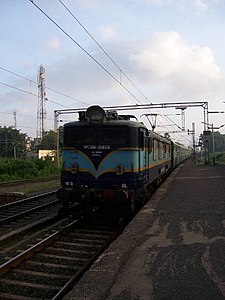Indian locomotive class WCAM 1
| WCAM-1 | |||||||||||||||||||||||||||||||||||||||||
|---|---|---|---|---|---|---|---|---|---|---|---|---|---|---|---|---|---|---|---|---|---|---|---|---|---|---|---|---|---|---|---|---|---|---|---|---|---|---|---|---|---|

WCAM-1 # 21824 used for inaugural run of 12264/H Nizamuddin-Pune AC Super-fast Express
|
|||||||||||||||||||||||||||||||||||||||||
|
|||||||||||||||||||||||||||||||||||||||||
|
|||||||||||||||||||||||||||||||||||||||||
|
|||||||||||||||||||||||||||||||||||||||||
|
|||||||||||||||||||||||||||||||||||||||||
| Type and origin | |
|---|---|
| Power type | Electric |
| Designer | RDSO |
| Builder | Chittaranjan Locomotive Works |
| Build date | 1973 - 9 |
| Total produced | 53 |
| Specifications | |
|---|---|
| Configuration: |
|
| • AAR | C-C |
| • UIC | Co'Co' |
| Gauge | 5 ft 6 in (1,676 mm) |
| Bogies | ALCo High-Adhesion Tri-mount cast |
| Wheel diameter | New: 1,092 mm (3 ft 7 in) Half-worn:1,055 mm (3 ft 5 1⁄2 in) Full-worn:1,016 mm (3 ft 4 in) |
| Wheelbase | 14,432 mm (47 ft 4 1⁄4 in) |
| Length | Over Coupler faces : 20.950 m (68 ft 8 3⁄4 in) Over : 19.680 m (64 ft 6 3⁄4 in) |
| Width | 3.055 m (10 ft 1⁄4 in) |
| Height | 4.121 m (13 ft 6 1⁄4 in) |
| Axle load | 18.8 tonnes (18.5 long tons; 20.7 short tons) |
| Loco weight | 112.8 tonnes (111.0 long tons; 124.3 short tons) |
| Electric system/s | 25 kV 50 Hz AC, 1.5 kV DC overhead |
| Current pickup(s) | pantograph a separate one for AC and DC |
| Traction motors | Alstom TAO-659A1 |
| MU working | Not possible |
| Loco brake | Air/Parking |
| Train brakes | Vacuum/Air |
| Safety systems | Slip Control, Main Overload relay, Motor Overload Relay, Over Voltage relay, Earth fault relay, Low Pressure Governor and Brake Cylinder Cutoff Valve |
| Performance figures | |
|---|---|
| Maximum speed | Starting : 100 km/h (62 mph)(DC)/120 km/h (75 mph)(AC) Continuous : 60 km/h (37 mph)(AC)/35 km/h (22 mph)(DC) |
| Power output | 1 hour : 3,850 hp (2,871 kW)(AC) Continuous : 2,350 hp (1,752 kW)(DC) 3,640 hp (2,714 kW)(AC) |
| Tractive effort | Starting : 33,840 kgf (331,900 N; 74,600 lbf)(AC)/23,200 kgf (228,000 N; 51,000 lbf)(DC) Continuous : 22,800 kgf (224,000 N; 50,000 lbf)(DC)/16,000 kgf (160,000 N; 35,000 lbf)(AC) |
| Factor of adh. | Dry : 0.3(AC)/0.25(DC) |
| Career | |
|---|---|
| Operators | Indian Railways |
| Numbers | Starting from 21800 to 21852 |
| Nicknames | "Vallabh" for No.-21800 |
| Locale | Western Railway |
| First run | 1975 |
| Last run | 2015 |
| Disposition | active |
WCAM-1 is a class of locomotives used in the Indian Railways system. They are the first of the WCAM series. These locos can be seen in Mumbai-Vadodara-Ahmedabad section but occasionally they travel up to Pune but not beyond these because the maintenance facilities are not available beyond this point. An occasional loco has also appeared on Mumbai C.S.T.-Igatpuri route. This locos works on both AC as well as DC as their classification suggests.
These locos hauls the trains from DC section of suburban trains to AC section and performs very critical task as they can easily operate on both AC and DC. However they perform poorly in DC mode compared to AC mode but they are very robust and have easy operating and handling characteristics. These loco are now very less in use as Western Railways DC section has been converted in AC. They are used for the second tier general/express/super-fast trains of Western Railway. These are 1st class of Wide Gauge's(W) Bi-current charged(CA - runs both under AC and DC) and Mixed load series(M - hauls both passenger and freight trains). These were the first electric locomotives to enter Western Railway's Mumbai division. Prior to that steam and diesel locomotives used to haul trains in Western Railway's Mumbai division. These brought end to the steam era in this division. They were also the first locomotives allotted to Valsad (BL) shed. They are now the most low-horse powered surviving electric locomotives under AC in the country along with WAM-4. Their top speed under DC is also the lowest compared to other Bi-current charged locomotives. They were the first Bi-current charged locomotives in the country. Initially all were vacuum braked but were retrofitted with air brakes to make them dual braked. Some also had there vacuum brakes replaced with air brakes. Due to the reduction of DC territory in Mumbai, some locomotives had their DC equipment removed at the shed. Now these locomotives only run under AC territory. They are soon to be decommissioned.
Introduced in 1975. One of the single pantographs on the WCAM-1 is used in dc traction; the other one carries ac current. The two pantographs are not identical, though similar in design. Originally built with vacuum brakes only, although a few (Nos. 21805, 21807, 21812, 21828, 21838, 21844, 21845, and 21850) have both vacuum and air brakes. They also lack dynamic brakes.
The WCAM-1 does not use a variable ratio auto-transformer in AC mode like the others; it uses a fixed-ratio transformer and rectifier bank to convert the OHE supply to 1500VDC. The design of the transformers and notches makes this a hard machine to operate, with the fusible links tending to blow often. Of the 28 notches, notches 4, 14, 21, and 28 can be used for continuous operation, although notch 4 was intended for low-speed shunting and is very ineffective. Notches 14, 21, and 28 are the terminal notches of the series, series-parallel, and parallel circuit notch sequences. In DC mode, the WCAM-1 uses resistor banks for speed control.
...
Wikipedia
